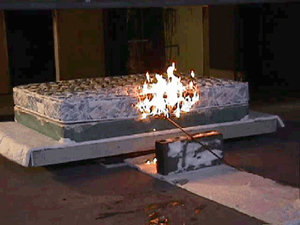February 26, 2007
The Burning Bed—Revisited

By Michael D. Shaw
Many readers will remember “The Burning Bed” as the title of a 1984 TV movie, about Francine Hughes, a battered housewife who finally takes revenge on her husband by setting him on fire as he sleeps. Former poster queen Farrah Fawcett played the lead role.
Notwithstanding homicidal intentions, research shows that half of home fire fatalities occur between 10 PM and 6 AM, with most victims asleep at the time of the fire. Indeed, many homeowners seem well-versed on the dangers inherent in the kitchen, where high heat is used routinely and the garage, where many hazardous chemicals can be stored. Fewer are aware that nearly 1,000 American lives are lost each year to fires that start in bedrooms.
Sad to say, this particular room, that we like to regard as a sanctuary of sleep and comfort, can become quite a hazardous area. In fact, the most recent statistics indicate that there were an estimated 53,500 residential bedroom fires in the U.S., and that includes 17,800 mattress and bedding fires.
Listen to Pat Martin of the Sleep Products Safety Council:
“Most home fires, especially bedroom fires, can be prevented. Many bedroom fires are caused by child play, misuse or poor maintenance of electrical devices, careless use of candles, and smoking in bed.”
The Council offers some common sense tips…
- Be sure to keep flammable items like bedding, clothes and curtains at least three feet away from portable heaters or lit candles.
- Electrical outlets should never be overloaded.
- Never operate items like appliances or electric blankets if they have frayed power cords.
- And, again—never smoke in bed, a foolhardy activity which accounts for about 30 percent of bedroom fires.
- Replace mattresses manufactured before the 1973 Federal Mattress Flammability Standard.
At the same time, though, you’ve got to get the message out to your kids. According to Chief Mike Love, a fire marshal with the Montgomery County, Maryland Fire and Rescue Service:
“Fires and burns are leading causes of injury and death to children. Unfortunately, many of these fires are started by children themselves. Two-thirds of bedroom fires are started by children playing with matches or lighters.”
As to how all this applies to general fire safety…
- Avoid storing old mattresses in the home or garage.
- Designate two escape routes from each bedroom and practice them regularly.
- Install and maintain a working smoke alarm outside of every sleep area and remember to change the battery at least once a year.
- Teach everyone the “Stop, Drop, and Roll” technique in case clothing catches on fire.
Here is Stop, Drop, and Roll:
- Stop—The fire victim must stop, ceasing any movement which may fan the flames or hamper those attempting to put the fire out.
- Drop—The fire victim must drop to the ground, laying down if possible.
- Roll—The fire victim must roll on the ground in an effort to extinguish the fire by depriving it of oxygen. If the victim is on a rug or one is nearby, he can roll the rug around himself to further extinguish the flame.
The effectiveness of stop, drop, and roll may be further enhanced by combining it with other firefighting techniques, including the use of a fire extinguisher, dousing with water, or fire beating.
While the majority of bedroom fires start off small, there is only a brief window of opportunity for someone to escape. The difference between life and death can literally be only a matter of seconds, especially since potential victims are often asleep. Note that the size of the blaze doubles itself every minute in a mattress fire, and deadly carbon monoxide can kill quicker than the flames.
Finally, bear in mind that in less than five minutes, most mattresses, when ignited, can reach what fire officials call flashover temperatures, and this is a frightful situation.
In flashover, the majority of surfaces in a space are heated to the point (known as fire point) at which they give off flammable gases that are hot enough to sustain combustion. Flashover usually occurs between 600-700 °C (1112-1292 °F).
The classic example of flashover is where a piece of furniture is set alight in a residence. The fire on the furniture produces a layer of hot smoke across the ceiling in the room. The radiated heat from this layer causes pyrolysis (heating of the other surfaces in the room, causing them to give off flammable gases). When the surface temperatures become high enough, these gases ignite and within a few seconds, every surface in the room may be on fire.
With this sort of scenario as a distinct possibility, we should all pay great attention to preventing bedroom fires.

